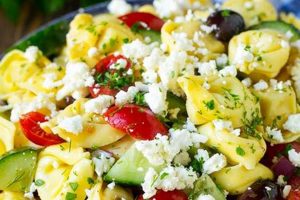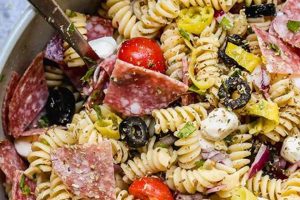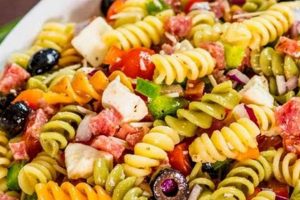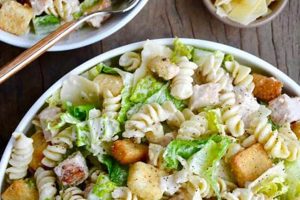Dishes centered around chilled, cooked pasta, combined with various ingredients like vegetables, proteins, and a dressing, often feature feta as a key component. A classic example incorporates cooked rotini pasta, chopped cucumbers, tomatoes, red onion, Kalamata olives, and crumbled feta, tossed in a lemon-herb vinaigrette.
The inclusion of this cheese offers a salty, tangy flavor profile that complements the other components. Its crumbly texture adds a pleasant contrast to the pasta and vegetables. Furthermore, feta contributes nutritional value, being a source of calcium and protein. While the precise historical origins of these salads are difficult to pinpoint, the combination of pasta, fresh produce, and cheese reflects culinary traditions across the Mediterranean region.
The following sections will delve into specific recipe variations, exploring different pasta shapes, vegetable combinations, dressing options, and techniques for achieving optimal flavor and texture.
Tips for Exceptional Pasta Salads with Feta
Optimizing ingredient selection and preparation techniques elevates these salads from simple to extraordinary. Attention to detail ensures a balanced flavor profile and desirable texture.
Tip 1: Pasta Selection: Short, sturdy pasta shapes hold their form well and capture the dressing effectively. Rotini, fusilli, penne, and farfalle are excellent choices.
Tip 2: Optimal Cooking: Cook pasta al dente to prevent a mushy texture. Rinse the cooked pasta under cold water to stop the cooking process and firm the pasta.
Tip 3: Fresh, High-Quality Ingredients: Select ripe, flavorful vegetables and high-quality feta. Consider using a variety of colors and textures for visual appeal.
Tip 4: Balancing Flavors: The saltiness of feta pairs well with acidic elements. Incorporate ingredients like lemon juice, vinegar, or olives to achieve this balance.
Tip 5: Dressing Emulsification: A stable emulsion ensures even coating and flavor distribution. Whisk the dressing ingredients vigorously until well combined.
Tip 6: Proper Chilling: Allow the salad to chill for at least 30 minutes before serving. This allows the flavors to meld and the salad to reach an optimal temperature.
Tip 7: Garnish and Presentation: Fresh herbs, a sprinkle of extra feta, or a drizzle of olive oil can enhance the visual appeal and add a final layer of flavor.
By following these guidelines, one can create flavorful, visually appealing, and texturally satisfying pasta salads.
These tips provide a foundation for successful pasta salad preparation. Experimentation with various ingredient combinations and dressings allows for personalized culinary creations.
1. High-quality Feta
Feta cheese constitutes a crucial ingredient in many pasta salads, contributing a salty, tangy flavor and crumbly texture. The quality of feta significantly influences the overall dish’s success. Substandard feta can result in a bland, unappealing salad, while high-quality feta elevates the sensory experience.
- Milk Source
Authentic feta, traditionally made from sheep’s milk or a blend of sheep and goat’s milk, possesses a distinct flavor profile. Cow’s milk feta often exhibits a milder, less complex taste. The milk source directly impacts the final flavor and texture of the cheese, influencing its compatibility with other salad ingredients.
- Texture and Appearance
High-quality feta presents a firm yet crumbly texture. It should appear white and slightly grainy. Excessive moisture indicates lower quality, potentially leading to a watery salad. Proper texture ensures the feta distributes evenly throughout the salad and contributes a pleasant mouthfeel.
- Salt Content and Brine
Feta is typically stored in brine, which preserves its freshness and influences its saltiness. High-quality feta exhibits a balanced salt level, enhancing the overall flavor profile without overpowering other ingredients. Rinsing the feta before use can help adjust the saltiness according to preference.
- Freshness
Fresh feta provides the best flavor and texture. Check expiration dates and avoid feta that appears discolored or smells unpleasant. Proper storage, ideally in brine within a sealed container in the refrigerator, maintains feta’s freshness and quality.
Selecting high-quality feta is essential for creating a delicious and satisfying pasta salad. The milk source, texture, salt content, and freshness all contribute to the final product’s overall quality. Investing in premium feta ensures a more enjoyable culinary experience.
2. Complementary Ingredients
The success of pasta salad recipes featuring feta cheese hinges significantly on the thoughtful selection of complementary ingredients. These ingredients interact with the feta’s salty, tangy profile, creating a balanced and flavorful dish. Careful consideration of texture, flavor, and color ensures a harmonious and appealing culinary experience.
- Vegetables:
Fresh vegetables provide textural contrast and contribute essential nutrients. Crisp cucumbers, juicy tomatoes, and sweet bell peppers offer a refreshing counterpoint to the rich feta. Roasted vegetables, such as zucchini or eggplant, introduce a smoky depth. The choice of vegetables influences the salad’s overall flavor profile and visual appeal.
- Proteins:
Optional protein additions enhance the salad’s heartiness and nutritional value. Grilled chicken or shrimp provide lean protein, while chickpeas or cannellini beans offer a vegetarian alternative. The protein choice should complement the feta and other ingredients without overpowering the delicate balance of flavors.
- Other Flavor Enhancers:
Ingredients like olives, capers, and sun-dried tomatoes introduce bursts of briny, salty, or umami flavors that harmonize with the feta. Fresh herbs, such as dill, mint, or oregano, provide aromatic complexity. These additions elevate the salad beyond a simple combination of ingredients, creating a multi-layered sensory experience.
- Grains and Seeds:
Adding grains like quinoa or orzo, or seeds like sunflower or pumpkin seeds, introduces textural variety and nutritional benefits. These additions enhance the complexity of the salad, offering a satisfying chewiness that complements the feta’s crumbly texture. The choice of grains or seeds should align with the desired overall flavor profile.
The interplay of these complementary ingredients is crucial in crafting a successful pasta salad with feta cheese. The careful balance of flavors, textures, and colors elevates the dish from simple to sophisticated, ensuring a delightful culinary experience.
3. Balanced Dressing
The dressing serves as a unifying element in pasta salad recipes featuring feta cheese, binding the diverse ingredients and contributing significantly to the overall flavor profile. A balanced dressing complements the feta’s saltiness and tanginess without overpowering the other components. Achieving this balance requires careful consideration of acidity, sweetness, and the inclusion of complementary flavors.
- Acidity:
Acidity provides a necessary counterpoint to the richness of the feta and other ingredients. Lemon juice, red wine vinegar, or white wine vinegar are common acidic components in dressings for these salads. The level of acidity should be sufficient to brighten the flavors but not so overpowering as to create an overly tart taste. The specific acid chosen can also contribute subtle flavor nuances, such as the citrusy notes of lemon or the fruity undertones of certain vinegars.
- Sweetness:
A touch of sweetness can balance the acidity and enhance the complexity of the dressing. A small amount of honey, maple syrup, or even a pinch of sugar can achieve this balance. However, excessive sweetness can detract from the savory nature of the salad. The goal is to create a subtle interplay between sweet and acidic notes that complements the feta’s flavor profile.
- Complementary Flavors:
Incorporating complementary flavors into the dressing further enhances the overall taste experience. Minced garlic, Dijon mustard, or dried herbs can add depth and complexity. These additions should be used judiciously to avoid overpowering the other flavors. The specific complementary flavors chosen should harmonize with the other ingredients in the salad, creating a cohesive and well-rounded taste.
- Oil:
The oil component of the dressing contributes richness and helps distribute the flavors throughout the salad. Extra virgin olive oil is a popular choice, offering a fruity flavor and healthy fats. Other oils, such as avocado oil or grapeseed oil, can also be used. The oil should be of good quality and complement the other dressing ingredients. The ratio of oil to acid influences the dressing’s consistency and mouthfeel.
A well-balanced dressing elevates pasta salad recipes with feta cheese from simple to exceptional. The interplay of acidity, sweetness, complementary flavors, and oil creates a harmonious blend that enhances the feta’s unique characteristics and unites all ingredients into a cohesive and flavorful dish. The careful consideration of these elements ensures a satisfying and enjoyable culinary experience.
4. Proper Pasta Cooking
Proper pasta cooking is crucial for pasta salad recipes featuring feta cheese. The pasta’s texture significantly impacts the overall enjoyment of the dish. Overcooked pasta becomes mushy and absorbs excessive dressing, leading to a heavy, unappetizing salad. Conversely, undercooked pasta offers an unpleasant, firm bite. The ideal texture is al dente firm to the bite, yet cooked through. This texture provides a pleasant chewiness and ensures the pasta holds its shape well when combined with other ingredients and the dressing.
Achieving al dente pasta requires attention to cooking time and adherence to package instructions. Salting the boiling water generously seasons the pasta from within. Testing the pasta for doneness just before the recommended cooking time is crucial. Once cooked, rinsing the pasta under cold water immediately halts the cooking process and removes excess starch, preventing the pasta from sticking together. This step is particularly important for pasta salads, as it helps maintain the pasta’s individual structure and prevents a gummy texture.
The impact of properly cooked pasta extends beyond texture. Al dente pasta absorbs the dressing more evenly, allowing the flavors to meld without becoming soggy. This contributes to a more balanced and flavorful salad. The improved texture also enhances the visual appeal of the dish, as the pasta maintains its shape and does not clump together. In pasta salad recipes with feta cheese, the firm texture of properly cooked pasta provides a pleasant contrast to the crumbly feta and the other ingredients, creating a more satisfying culinary experience. Neglecting proper pasta cooking can compromise the entire dish, regardless of the quality of the other ingredients.
5. Effective Chilling
Effective chilling is essential for optimizing the flavor and texture of pasta salad recipes incorporating feta cheese. Chilling allows the flavors of the various components, including the pasta, vegetables, feta, and dressing, to meld and harmonize. Moreover, proper chilling ensures food safety and maintains the desired textural integrity of the ingredients.
- Temperature and Time:
Chilling the pasta salad to a safe internal temperature, typically below 40F (4C), inhibits bacterial growth and ensures food safety. A chilling period of at least two hours, or preferably longer, allows the flavors to fully develop and integrate. Insufficient chilling can result in bland flavors and potential food safety risks.
- Flavor Development:
During chilling, the dressing’s flavors penetrate the pasta and other ingredients, resulting in a more cohesive and flavorful dish. The chilling process also allows the feta’s distinct salty and tangy notes to permeate the other components, creating a more balanced flavor profile. The low temperature slows down enzymatic activity, preserving the fresh flavors of the vegetables.
- Texture Enhancement:
Chilling firms the pasta and vegetables, enhancing their textural appeal. This is particularly important for pasta salads, as it helps prevent the pasta from becoming mushy or the vegetables from becoming limp. The cold temperature also solidifies the dressing slightly, contributing to a more desirable consistency and preventing the salad from becoming watery.
- Food Safety:
Maintaining a low temperature during chilling is crucial for preventing the growth of harmful bacteria, especially in salads containing perishable ingredients like feta cheese and fresh vegetables. Proper chilling practices mitigate food safety risks and ensure the salad remains safe for consumption. Adherence to recommended chilling temperatures and durations is essential for protecting against foodborne illnesses.
Effective chilling is integral to the success of pasta salad recipes with feta cheese. It enhances food safety, allows flavors to meld, and improves texture. By adhering to proper chilling techniques, one ensures a more enjoyable and safe culinary experience. A well-chilled pasta salad offers a refreshing and flavorful dish, ideal for warm weather or any occasion where a light yet satisfying meal is desired.
6. Thoughtful Presentation
Visual appeal significantly enhances the dining experience, even for seemingly simple dishes like pasta salad with feta cheese. Thoughtful presentation elevates the perceived value and enjoyment of the salad, transforming it from a casual meal to a more sophisticated culinary creation. Consideration of color, texture, and serving style contributes to a more appealing and appetizing final product.
- Color Palette:
A vibrant color palette stimulates appetite and enhances visual interest. The natural colors of fresh vegetables, combined with the white of the feta, create an attractive base. Incorporating ingredients with contrasting colors, such as brightly colored bell peppers, deep green spinach, or dark purple Kalamata olives, adds depth and visual appeal. A monochromatic color scheme, focusing on shades of green or red, can also create a striking presentation. Attention to color creates a more visually engaging dish.
- Textural Contrast:
Varying textures provide a more stimulating sensory experience. The crumbly texture of feta contrasts with the smooth pasta and the crisp vegetables. Incorporating elements like toasted nuts or crunchy croutons adds another layer of textural complexity. Garnishing with fresh herbs provides a soft, aromatic counterpoint. A balance of textures enhances the overall enjoyment of the salad.
- Serving Style:
The serving style influences the perception of the dish. A large bowl, ideal for family-style meals, creates a casual and inviting presentation. Individual portions, plated artfully, add a touch of elegance to the dining experience. Using unique serving vessels, such as small glass jars or hollowed-out vegetables, adds an element of surprise and sophistication. The choice of serving style depends on the occasion and the desired level of formality.
- Garnishes:
A simple garnish elevates the presentation and adds a final flourish of flavor. A sprinkle of fresh herbs, such as dill, mint, or parsley, provides a burst of color and aroma. A drizzle of olive oil adds richness and sheen. A scattering of toasted nuts or seeds provides textural contrast and visual interest. Garnishes should complement the existing flavors and enhance the overall aesthetic of the dish.
Thoughtful presentation maximizes the enjoyment of pasta salad with feta cheese. By considering color, texture, serving style, and garnishes, one can transform a simple dish into a visually appealing and appetizing culinary creation. Attention to these details demonstrates care and enhances the dining experience, making the salad more enticing and enjoyable for all. Even minor adjustments in presentation can significantly impact the overall perception and appreciation of this versatile dish.
Frequently Asked Questions
This section addresses common inquiries regarding pasta salads incorporating feta cheese, offering concise and informative responses to facilitate a deeper understanding of preparation techniques, ingredient selection, and storage practices.
Question 1: Can other cheeses be substituted for feta?
While feta provides a distinct salty, tangy flavor, substitutions are possible. Goat cheese offers a similar tang, while ricotta salata contributes a salty, firm texture. Consider flavor profiles when substituting to maintain balance.
Question 2: How long can pasta salad with feta be stored?
Refrigeration in an airtight container is crucial. Consume within three to five days for optimal quality and food safety. Monitor for signs of spoilage, such as off-odors or discoloration, before consumption.
Question 3: What pasta shapes are best suited for this type of salad?
Short, sturdy shapes like rotini, fusilli, or penne hold their shape well and capture the dressing effectively. Avoid long, thin pasta varieties, which tend to become tangled and clump together.
Question 4: Can the salad be made ahead of time?
Making the salad ahead enhances flavor melding. Prepare all components, including the dressing, and combine just before serving or several hours prior to allow flavors to combine in the refrigerator.
Question 5: How can one reduce the saltiness of the salad if too much feta is added?
Adding more non-salty ingredients like pasta or vegetables dilutes the overall saltiness. A squeeze of lemon juice can also help balance the flavor profile. Rinsing the feta before adding it to the salad can also help reduce saltiness.
Question 6: What are some suitable vegetarian protein options besides feta?
Chickpeas, cannellini beans, or lentils offer plant-based protein and complement the flavors of feta and vegetables. These additions enhance the salad’s nutritional value and provide a satisfying texture.
Understanding these key aspects ensures optimal flavor, texture, and safe enjoyment. Adherence to proper storage guidelines is crucial for maintaining freshness and preventing spoilage.
The following section offers a selection of diverse and flavorful pasta salad recipes showcasing feta cheese, catering to various dietary preferences and culinary tastes.
Conclusion
Exploration of pasta salad recipes incorporating feta cheese reveals the importance of ingredient selection, preparation techniques, and flavor balancing. High-quality feta, fresh vegetables, and a well-balanced dressing contribute significantly to the overall success of these dishes. Proper pasta cooking and effective chilling techniques further enhance texture and flavor development. Thoughtful presentation elevates the dining experience, transforming a simple pasta salad into a visually appealing culinary creation.
Culinary experimentation within this framework allows for diverse flavor profiles and personalized variations. The versatility of pasta salad recipes featuring feta cheese offers a canvas for culinary creativity, adaptable to various dietary preferences and occasions. Continued exploration of ingredient combinations and flavor pairings promises further development and refinement within this culinary domain.






